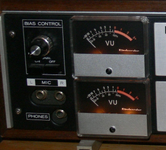C
ChristopherTheo
New member
Hey all.
I have a focusrite 6i6 and a revox b77 (rca to jack cables as well).
I have some songs I want to give a warming up from my reel to reel machine. I dont know how to go about hooking it up, giving tape saturation into my digital mixes on logic.
I'd like to do something like this dude.
DX5 compressing with analog tape - YouTube
(2:27)
Thanks guys.
-Chris
I have a focusrite 6i6 and a revox b77 (rca to jack cables as well).
I have some songs I want to give a warming up from my reel to reel machine. I dont know how to go about hooking it up, giving tape saturation into my digital mixes on logic.
I'd like to do something like this dude.
DX5 compressing with analog tape - YouTube
(2:27)
Thanks guys.
-Chris

